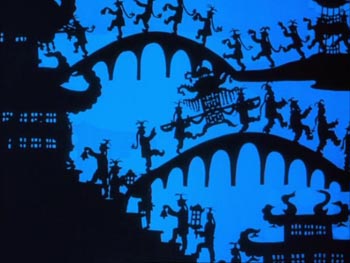Historians, film buffs, and Disney fanatics all cite Snow White and the Seven Dwarfs (1937) as the first animated feature. While it is the first animated feature as we Americans tend to think of animation, actually that “first” honor goes to a little known, innovative oddity from eleven years earlier. The Adventures Of Prince Achmed (1926) is a labor of love from the pioneering female German filmmaker Lotte Reiniger and her husband, Carl Koch.
What makes Achmed still unique 88 years later is animation entirely composed of cutout silhouettes. The result was one of the silent era’s most enchanting and captivating films. It is also a lucid reminder that the medium of film was at its most innovative in its infancy, before the rules were set and the mediums defined.
Reiniger lucked into a patron for her artistic efforts: Louis Hagen supplied her with enough film stock and financing to proceed with her project. Using scissors and black construction paper as her primary tools, Reiniger spent three years meticulously working in an attic on Achmed with a small crew that included her husband/cinematographer, Koch.
Influenced in part by Georges Méliès and Arabian Nights, Reiniger created a world of sensuous, exquisitely detailed beauty. The film has an almost surprisingly coherent and linear narrative, given that Reiniger was embraced by the European avant-garde. Unfortunately, the director had difficulty booking Achmed, and with the exception of Dr. Doolittle And His Animals (1928), the rest of her career was relegated to short films. There was work on a third feature, to be based on Maurice Ravel’s enchanting opera, “L’Enfant et les Sortilèges”; unfortunately, rights to the music could not be secured and the film was abandoned. The Adventures Of Prince Achmed is the only one of Reiniger’s films to date that has seen a home video release. Some of her shorts occasionally appear on television, but often in truncated versions. One such example is Doolittle, which has aired with added (and intrusive) voice over narration, coupled with woefully inadequate projection speeds. Fortunately, YouTube has been more respectful. The Star of Bethlehem (1921), Cinderella (1922), The Adventures of Prince Achmed, Papageno (from Mozart’s “The Magic Flute”) (1935), The Magic Horse (1953), and Jack and The Beanstalk (1955) along with a short documentary of her work can all be found there. The documentary shows her storyboarding techniques and the almost rapid-fired speed at which she crafted her baroque figures.
 There is a noticeable gap of activity in Reiniger’s filmography from 1938 to the early 1950s. With the rise of Fascism, Reiniger and Koch struggled to flee Germany. Although not Jewish, politically they leaned left, which marked them as subversives. Jean Renoir was among those who aided the couple, but they lived in abject poverty until finally being able to settle in England in 1949. Despite the initial financial failure of Achmed, Reiniger and Koch were respected in film circles and were able to be relatively prolific.
There is a noticeable gap of activity in Reiniger’s filmography from 1938 to the early 1950s. With the rise of Fascism, Reiniger and Koch struggled to flee Germany. Although not Jewish, politically they leaned left, which marked them as subversives. Jean Renoir was among those who aided the couple, but they lived in abject poverty until finally being able to settle in England in 1949. Despite the initial financial failure of Achmed, Reiniger and Koch were respected in film circles and were able to be relatively prolific.
Achmed is of its time in its portrayal of the good guys as completely good, bad guys as completely bad, and the pretty girl as in need of saving (Reiniger’s later films frequently had biblical, Victorian, fairy tale, and operatic themes). Still, it’s put over so beautifully, even the most hardened cynics will hardly care. The color tinting renders the film a phantasmagoric smorgasbord of gemstones. Achmed is awash in emeralds, sapphires, rubies, garnets, aquamarines, amethyst, topaz, citrine, tanzanite, and fire opal.
The Adventures of Prince Achmed weaves interrelated narratives involving our protagonist, his princess sister, their Caliph father, an erotic heroine (who Achmed voyeuristically spies on while she is bathing), a flying horse, a malevolent shape shifting African magician, the Witch of the Fiery Mountain, dancing harlequins, sphinxes, terrifying demons, Aladdin, and the genie of the magic lamp. Locales include an exotic island, a majestic palace, Peru, and China.
Reiniger was master of her medium and an innovator. Every step through her unique world is an enchanting one.
